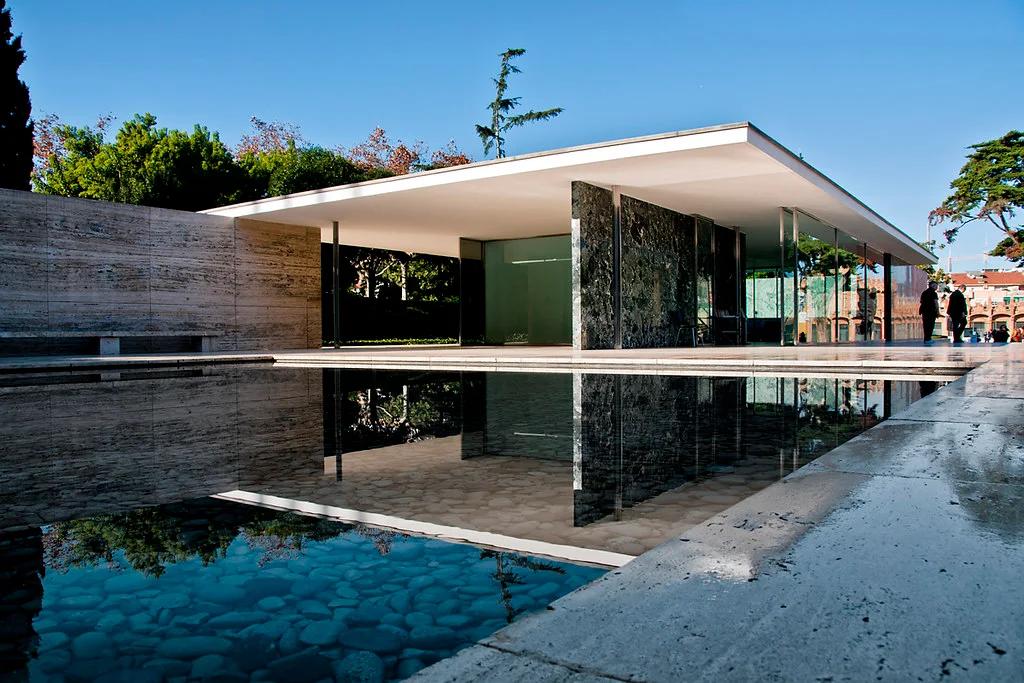Modern Architecture: Origins, Emergence, and Iconic Projects
Defining Modern Architecture
Architecture is not just a functional necessity but an art form that shapes our cities and landscapes. The Modern Architectural style, however, born out of a need to break away from traditional designs, has become a defining feature of the 20th century.
Its sleek lines, innovative designs, and minimalist aesthetics have become a defining feature of urban landscapes worldwide. This architectural style emerged as a response to the industrial revolution, aiming to break free from traditional design principles and embrace new materials and technologies.
Modern architecture is an influential design movement that emerged in the late 19th and early 20th centuries. It revolutionized the field of architecture, departing from traditional styles and embracing innovative materials, structural techniques, and functional aesthetics.
 |
| Modern architecture is the art that shaped our cities and landscapes into innovative designs, and minimalist aesthetics, Image by Pexels from Pixabay |
Emergence of Modern Architecture
Modern architecture emerged as a response to the industrialization of the late 19th and early 20th centuries. With its departure from historical styles, embrace of innovative materials, and focus on functionality, modern architecture revolutionized design.
Iconic projects like Fallingwater, Villa Savoye, and the Sydney Opera House (refer to the next section) continue to inspire architects and captivate the public. Moreover, contemporary architects like Zaha Hadid and Bjarke Ingels carry the torch of modern architecture, further pushing the boundaries of design and shaping the built environment of today and the future.
Origins and Key Principles of Modern Architecture
The emergence of modern architecture can be traced back to the late 19th century, as architects sought to challenge the prevailing architectural norms of the time. They aimed to create functional spaces that aligned with the needs of the rapidly changing industrial society. One of the critical catalysts for this movement was the Arts and Crafts movement, which emphasized craftsmanship, simplicity, and a return to handmade goods.
Furthermore, the Bauhaus school, founded in Germany in 1919, became the epicenter of modern architecture. Led by visionary architect Walter Gropius, the Bauhaus embraced the principles of functionalism, rationality, and the integration of art and technology. It fostered an interdisciplinary approach to design, combining architecture, industrial design, and fine arts.
In the same context, Modern architecture drew inspiration from various sources and incorporated different design principles. It is characterized by several key features which include:
First and foremost, modern architecture embraces simplicity and minimalism, focusing on clean lines, geometric forms, and a sense of openness. It rejects excessive ornamentation and instead emphasizes functionality and efficiency.
Another hallmark of the cited architectural style is the usage of new materials and construction techniques, such as steel, concrete, and glass, which allow for innovative and daring designs. Natural light and integrating the surrounding environment are also important considerations in modern architecture, with large windows and open floor plans creating a seamless connection between indoor and outdoor spaces.
Finally, modern architecture often reflects the spirit of the times, incorporating technological advancements and social changes into its designs, while still maintaining a timeless quality that transcends specific eras. Here are some key elements that define it well:
a) Functionality: Modern architects prioritized functionality over ornamental embellishments. Buildings were designed with a purpose, emphasizing efficiency, usability, and adaptability.
b) Simplified Forms: Traditional decorative elements were replaced with clean, geometric shapes and sleek lines. The emphasis was on creating visually appealing compositions through simplicity and proportion.
c) Innovative Materials: Modern architecture embraced new materials like reinforced concrete, steel, and glass. This allowed for the creation of large, open spaces and expansive facades with abundant natural light.
 |
| Modern architecture introduces new construction materials never used before, such as reinforced concrete, steel, and glass. Image by PublicDomainPictures from Pixabay |
d) Integration of Indoor and Outdoor Spaces: Architects sought to blur the boundaries between indoor and outdoor spaces by incorporating elements like large windows, open floor plans, and balconies. This integration aimed to enhance the connection between humans and nature.
e) Rejection of Historical Styles: Modern architecture rejected the historical revival styles that dominated the previous era. Instead, it embraced a fresh, forward-looking aesthetic that celebrated the possibilities of the modern age.
Some Iconic Projects with Modern Architecture
Several iconic architectural projects around the world showcase the brilliance and innovation of modern architecture. Here are four notable examples:
1. Fallingwater, USA: Designed by Frank Lloyd Wright in 1935, Fallingwater is a masterpiece of modern residential architecture. This cantilevered house in Pennsylvania integrates harmoniously with its natural surroundings, seemingly floating over a waterfall.
2. Barcelona Pavilion, Spain: Created by Ludwig Mies van der Rohe for the 1929 Barcelona International Exhibition, this pavilion exemplifies modern architecture's elegance and simplicity. It features a minimalistic design, with open spaces, translucent walls, and sleek lines.
 |
| Barcelona Pavilion in Spain, created for the 1929 Barcelona International Exhibition, by Ludwig Mies van der Rohe, Image by: c2.staticflickr.com |
3. Sydney Opera House, Australia: Designed by Danish architect Jørn Utzon, the Sydney Opera House is an architectural icon and a UNESCO World Heritage site. Completed in 1973, its unique sail-shaped roofs make it one of the most recognizable structures in the world.
4. Guggenheim Museum Bilbao, Spain: Designed by Frank Gehry and completed in 1997, this museum is a triumph of deconstructivist architecture. Its curvilinear forms, clad in titanium, have redefined the urban landscape of Bilbao and attracted global attention.
 |
| Guggenheim Museum Bilbao, Spain, and designed by Frank Gehry. This museum exemplifies deconstructivist architecture in all its forms. Photo by: Pinterest. |
Pioneers of Modern Architecture Today
Modern architecture continues to evolve, thanks to the efforts of contemporary pioneers who push boundaries and redefine the built environment. Here are a few architects who have made significant contributions to modern architecture in recent times:
➤ Read more about famous architecture pioneers and their creations.
a) ZAHA HADID: Known for her fluid and dynamic designs, the late Zaha Hadid was an influential figure in contemporary architecture. Her projects, such as the Guangzhou Opera House in China and the London Aquatics Centre, showcase her signature style that challenges traditional architectural conventions.
b) BJARKE INGELS: Bjarke Ingels is a Danish architect known for his innovative and sustainable designs. His firm, BIG (Bjarke Ingels Group), has designed notable projects such as the 8 House in Copenhagen and VIA 57 West in New York City. Ingels emphasizes the integration of social and environmental considerations in his designs.
c) JEANNE GANG: Jeanne Gang, the founder of Studio Gang, is renowned for her focus on sustainable design and community engagement. Her projects include the Aqua Tower in Chicago and the Solar Carve Tower in New York City. Gang's designs often incorporate natural elements and emphasize the relationship between architecture and its surroundings.
Conclusion
In the end, Modern architecture has revolutionized how we perceive and interact with our built environment. From its origins in the early 20th century to the visionary projects of today, this architectural style continues to shape skylines and redefine urban spaces.
With its emphasis on functionality, simplicity, and innovation, modern architecture showcases the power of human creativity and the ability to adapt to an ever-changing world. As we move forward, the pioneers of modern architecture will continue to inspire and influence the architectural landscape, shaping the cities of tomorrow.
In a world that constantly evolves, modern architecture remains a testament to the power of human creativity and the pursuit of innovative solutions. By studying its origins, iconic projects, and the work of modern architectural pioneers, we gain a deeper appreciation for the impact of this influential design movement on our built environment.
.png)






